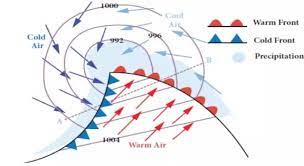Temperate Cyclones are also known as mid-latitude or frontal cyclones, are large-scale weather systems that occur in the middle latitudes of the Earth. These weather systems are crucial in determining the weather patterns in many regions of the world, including Europe, North America, and Asia. Understanding temperate cyclones is crucial in predicting and explaining the weather patterns in these regions.

Table of Contents
Formation of Temperate Cyclones
Temperate cyclones form when two air masses with different temperature and moisture characteristics meet and a front is formed. A front is a boundary between two air masses, and when it forms, it can lead to the development of clouds and precipitation.
The formation of a temperate cyclone begins with a warm air mass moving into a cold air mass. As the warm air mass moves into the cold air mass, it lifts the cold air out of the way, leading to the formation of clouds and precipitation. This process creates a low-pressure area, which is the center of the temperate cyclone.
Around the center of the temperate cyclone, winds circulate in a counter-clockwise direction in the Northern Hemisphere and in a clockwise direction in the Southern Hemisphere. This wind circulation, combined with the low-pressure area, helps to pull in air from the surrounding areas, causing the temperate cyclone to grow in size.
Structure of Temperate Cyclones
Temperate cyclones have a well-defined structure, with distinct features that help meteorologists identify and track these weather systems. The center of the temperate cyclone is called the “low,” and it is characterized by low atmospheric pressure and weak winds.
Around the low, there is a warm sector, which is the area between the warm front and the cold front. The warm sector is characterized by warm and moist air, which can lead to the formation of clouds and precipitation.
On the other side of the low, there is a cold sector, which is the area between the cold front and the warm front. The cold sector is characterized by cold and dry air, which can lead to clear skies and cool temperatures.
Impact of Temperate Cyclones on Weather
It have a significant impact on the weather patterns in many regions of the world. As they move, they bring with them their temperature and moisture characteristics, influencing the weather in the areas where they move.
In the warm sector, the warm and moist air can lead to the formation of clouds and precipitation, causing wet and rainy weather. In the cold sector, the cold and dry air can lead to clear skies and cool temperatures, causing dry and cool weather.
In addition to precipitation and temperature, temperate cyclones can also bring strong winds, especially near the center of the low. These winds can cause damage and disrupt transportation, making it important to track temperate cyclones and be prepared for any potential impacts.
Conclusion
In conclusion, they are large-scale weather systems that occur in the middle latitudes of the Earth. They form when two air masses with different temperature and moisture characteristics meet and a front is formed, and they have a well-defined structure with distinct features.
Temperate cyclones have a significant impact on the weather patterns in many regions of the world, bringing with them precipitation, temperature changes, and strong winds. Understanding temperate cyclones is crucial in predicting and explaining the weather patterns in these regions and being prepared for any potential impacts.
Important Links